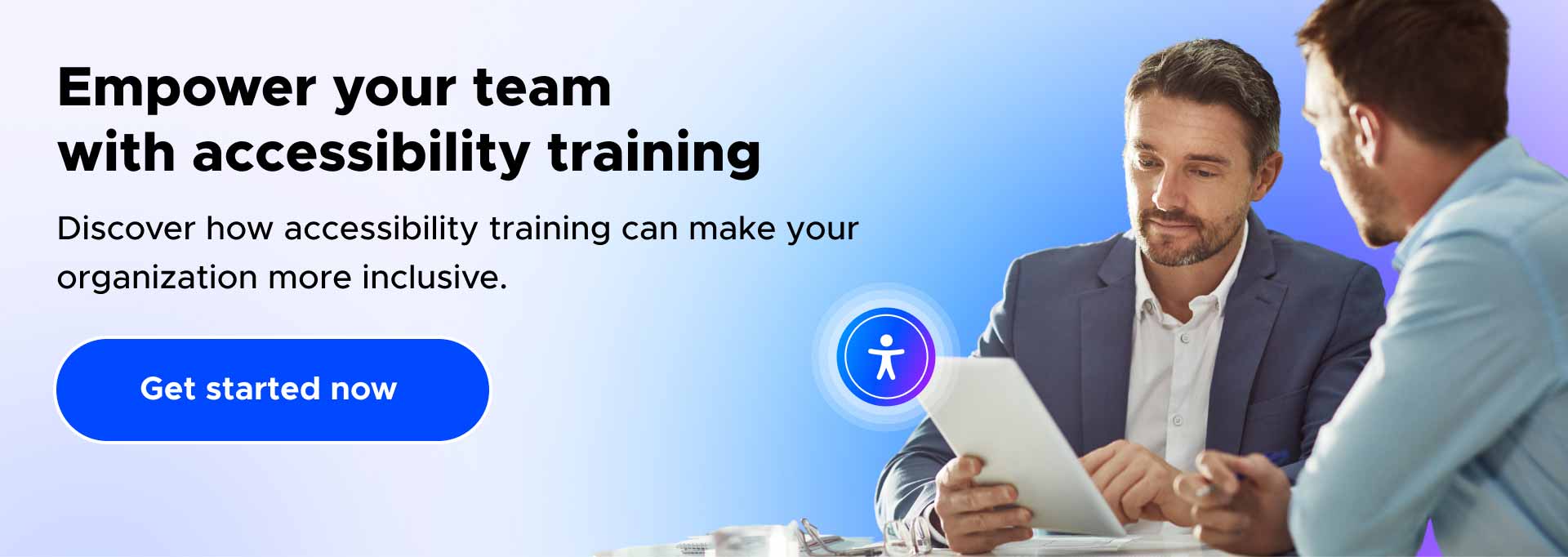Accessibility training: how to build an inclusive digital culture

Accessibility might still be a fairly new idea for many organizations but fortunately, it’s now becoming a key focus. Embracing accessibility training shows a deliberate effort towards learning, understanding, empathy and a conscious move towards user-focused design. Committing to accessibility training is how organizations can truly walk the talk on inclusion. With accessibility training, every team member has the chance to contribute to a culture that actively designs physical and digital spaces with accessibility in mind.
Let’s take a closer look at what accessibility training is.
What is accessibility training?
Accessibility training is designed to help employees understand the challenges that individuals with disabilities face in their daily lives, including the specific accommodations they may need. By providing this training to both staff and management, we equip them with the necessary knowledge and skills to create environments that are truly accessible. This investment in training promotes inclusivity and opens up opportunities for a wider spectrum of people with different abilities to participate in all aspects of life.
Web accessibility training is often given less attention than it truly deserves, especially when you consider that it’s just as important as training for physical accessibility. Think about this: 16% of the world’s population live with a significant disability, yet 98% of websites aren’t fully accessible to them.
So, how can we bridge this digital divide?
Employers can play a big part by prioritizing accessibility in their digital strategies and providing ongoing training to their teams. They can also hire accessibility champions or advocates to help spread the word about the importance of accessible digital spaces to drive more widespread change.
Incorporating web accessibility into standard training programs should be a first port of call. Just as architects learn to design buildings with ramps and elevators, web developers and designers should be equipped to create sites that provide a great user experience, sites that everyone can navigate.
Lets learn more about how designers can benefit from accessibility training.
Why is accessibility training recommended for designers?
It’s a common concern for designers that creating accessible digital spaces might limit creativity and bring barriers to innovation. This simply isn’t the case and this thinking is exactly why accessibility training for designers is so important.
In reality, designing for accessibility often leads to greater creativity and innovation. When designers are trained in accessibility, they learn to approach problems from multiple perspectives, considering a wide range of user needs and experiences.
This holistic view encourages them to explore unconventional solutions and integrate versatile design elements that benefit all users, not just those with disabilities.
Accessibility training also equips designers with a deeper understanding of user interaction with digital environments, inspiring them to move away from traditional design strategies and push the boundaries of their roles.
What are the benefits of accessibility training courses?
Accessibility training comes with a bundle of benefits that can really transform an organization and its services. Here’s what it brings to the table:
1. Broader audience reach: By making your services accessible, you open your doors to a wider audience, including the millions of people with disabilities. This can lead to increased user engagement and a broader customer base.
2. Enhanced user experience: Accessibility training ensures that everyone, regardless of their abilities, has a positive experience on your website or using your products. This leads to higher satisfaction and loyalty.
3. Compliance and risk reduction: Many regions have legal requirements for accessibility. Training helps ensure compliance, reducing the risk of legal issues and potentially costly lawsuits.
4. Boost in innovation: When you aim to make products or services accessible, it often leads to innovative solutions that can improve usability for everyone, not just those with disabilities.
5. Improved brand image: Committing to accessibility reflects positively on your brand. It shows social responsibility and can enhance your reputation, attracting customers who value inclusivity.
6. Workplace inclusivity: Accessibility training isn’t just external; it improves your internal culture too. It promotes inclusivity, making your workplace more welcoming and supportive for employees with disabilities.
Investing in accessibility training is not just about meeting standards; it’s about enriching user interaction, tapping into new markets, and fostering a culture of inclusivity.
Why accessibility compliance training matters
Accessibility training isn’t just a valuable part of an organization’s culture—it’s also a legal imperative. As digital spaces expand and evolve, the legal frameworks that ensure their accessibility to all users, including those with disabilities, have also tightened. Legislation like the Americans with Disabilities Act (ADA) in the U.S., and similar laws globally, require that digital services provided by organizations, especially those in the public sector or serving the public, be accessible to everyone. This includes websites, mobile applications, and online systems.
Failing to provide accessible digital services can lead to significant legal consequences, including lawsuits, fines, and negative public relations. For example, in recent years, there has been a surge in litigation related to digital accessibility under the ADA, emphasizing the risk organizations face if they neglect this aspect of their digital presence.
Accessibility training equips organizations with the knowledge and skills needed to meet these legal requirements effectively. It helps developers, designers, and content creators understand how to implement and maintain accessibility features, such as keyboard navigation, screen reader compatibility, and appropriate color contrast.
By investing in this training, organizations comply with the law while positioning themselves as socially responsible entities.
Where can I access online accessibility training?
Here’s a list of reputable sources where you can access accessibility training, tailored for different needs and levels of expertise:
1. WebAIM (Web Accessibility In Mind): Offers a variety of online courses and resources focused on web accessibility techniques and policies.
2. W3C Web Accessibility Initiative (WAI): Offers training resources that help you learn about accessibility standards like WCAG and how to implement them.
3. Google’s accessibility fundamentals: Available on the Google Developers site, this free resource covers the basics of accessible design and development.
4. LinkedIn learning: Offers various courses on accessibility, including introductions to web accessibility and how to design inclusive systems.
5. ADA National Network: Joining an ADA compliance course will help you learn the requirements of the ADA, covering accessibility in physical and digital spaces.
UserWay: the start of your accessibility training journey
UserWay’s suite of solutions help designers and web content developers build accessibility into their sites from the outset. Powering digital accessibility and compliance on websites, apps and digital documents everywhere, UserWay’s Accessibility Widget can automatically find and fix accessibility errors on your site. Use this tool to partner in your training as you build your accessibility acumen and do web accessibility right for all of your users.
Start your accessibility journey today.
FAQS
What is UX accessibility training and who should participate in it?
UX accessibility training is a program designed to teach user experience designers how to create products that are usable by people of all abilities. It’s ideal for UX designers, web developers, and product managers who are involved in the design of digital interfaces.
Can UX accessibility training help improve the overall user experience?
Yes, UX accessibility training can enhance the overall user experience by ensuring that digital products are navigable for a diverse range of users, including those with disabilities.
What accessibility standards should I meet when designing a website?
The go-to standards for web accessibility are the Web Content Accessibility Guidelines (WCAG), a widely recognized set of recommendations. While not law itself, WCAG is often cited in legal accessibility requirements worldwide, making it a benchmark for accessible design.





Share